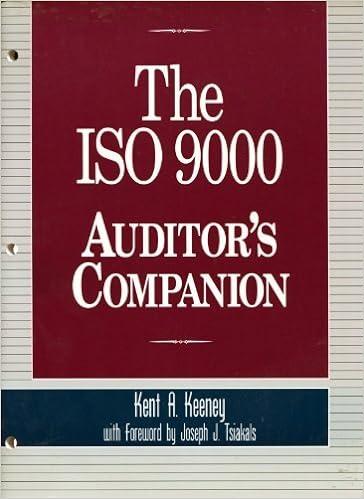Question
Case Study: Volantis Corporation What will your portfolio be worth in 10 years? In 20 years? When you stop working? The Human Resources Department at
Case Study: Volantis Corporation
What will your portfolio be worth in 10 years? In 20 years? When you stop working? The Human Resources Department at the Volantis Corporation was asked to develop a financial planning model that would help employees address these questions. John Snow was asked to lead this effort and decided to begin by developing a financial plan for himself. John has a degree in business and, at the age of 40, is making $80,000 per year. Through contributions to his companys retirement program and the receipt of a small inheritance, John has accumulated a portfolio valued at $50,000. John plans to work 20 more years and hopes to accumulate a portfolio valued at $1,000,000. Can he do it?
John began with a few assumptions about his future salary, his new investment contributions, and his portfolio growth rate. He assumed a 5% annual salary growth rate and plans to make new investment contributions at 6% of his salary. After some research on historical stock market performance, John decided that a 10% annual portfolio growth rate was reasonable. Using these assumptions, John developed the following Excel worksheet (see also the data file Volantis on Titanium):
The worksheet provides a financial projection for the next five years. In computing the portfolio earnings for a given year, John assumed that his new investment contribution would occur evenly throughout the year, and thus half of the new investment could be included in the computation of the portfolio earnings for the year. From the worksheet, we see that, at age 45, John is projected to have a portfolio valued at $116,321.
Johns plan was to use this worksheet as a template to develop financial plans for the companys employees. The data in the spreadsheet would be tailored for each employee, and rows would be added to it to reflect the employees planning horizon. After adding another 15 rows to the worksheet, John found that he could expect to have a portfolio of $772,722 after 20 years. Tom then took his results to show his boss, Daenerys Targaryen.
Although Daenerys was pleased with Johns progress, she voiced several criticisms. One of the criticisms was the assumption of a constant annual salary growth rate. She noted that most employees experience some variation in the annual salary growth rate from year to year. In addition, she pointed out that the constant annual portfolio growth rate was unrealistic and that the actual growth rate would vary considerably from year to year. She further suggested that a simulation model for the portfolio projection might allow Tom to account for the random variability in the salary growth rate and the portfolio growth rate.
After some research, John and Daenerys decided to assume that the annual salary growth rate would vary from 0 to 5% and that a uniform probability distribution would provide a realistic approximation. Volantis accountants suggested that the annual portfolio growth rate could be approximated by a normal probability distribution with a mean of 10% and a standard deviation of 5%. With this information, John set off to redesign his spreadsheet so that it could be used by the companys employees for financial planning.
Managerial Report
Play the role of John Snow, and develop a simulation model for financial planning. Write a report for Johns boss that includes each of the following:
1. Without considering the random variability, extend the current worksheet to 20 years. Confirm that by using the constant annual salary growth rate and the constant annual portfolio growth rate, John can expect to have a 20-year portfolio of $772,722. What would Johns annual investment rate have to increase to in order for his portfolio to reach a 20-year, $1,000,000 goal? (Hint: Use Goal Seek.)
2. Redesign the spreadsheet model to incorporate the random variability of the annual salary growth rate and the annual portfolio growth rate into a simulation model. (Note: new values of the salary and portfolio growth rates should be generated for each year, not just for each simulation trial. That means it is not sufficient to just change cells B7 and B8.) Assume that John is willing to use the annual investment rate that predicted a 20-year, $1,000,000 portfolio in part 1. Simulate Johns 20-year financial plan and use the results to comment on the uncertainty associated with the future value of Johns portfolio. In particular:
 a. Use a histogram to describe the probability distribution for the ending balance; report and interpret both the expected value and the standard deviation.
a. Use a histogram to describe the probability distribution for the ending balance; report and interpret both the expected value and the standard deviation.
b. What is the probability that the value of Johns portfolio will exceed $1,000,000 after 20 years? 3. Discuss how the financial planning model developed for John Snow can be used as a template to develop a financial plan for any of the companys employees. How could it be customized for each employee?
1 Four Corners 3 Age 4 Current Sal 5 Current Portfolio 6 Annual Investment Rate 7 Salary Growth Rate 8 Portfolio Growth Rate 40 $85,000 $50,000 6% 5% 10% 10 Year Beginning B Salary New Investment Earnings Ending Balance Age 60.35541 $72,01342 $85,11843 $99.82944 45 $5,100 $89,250$5,355 $93,7135,623 $5,904 $6,199 $50,000 S60,355 $72,013 $85,118 $99,829 $85,000 $5,255 $6,303 $7,482 $8,807 12 13 14 15 16 $98.398 $103.318 S10,293 $116.321Step by Step Solution
There are 3 Steps involved in it
Step: 1

Get Instant Access to Expert-Tailored Solutions
See step-by-step solutions with expert insights and AI powered tools for academic success
Step: 2

Step: 3

Ace Your Homework with AI
Get the answers you need in no time with our AI-driven, step-by-step assistance
Get Started


